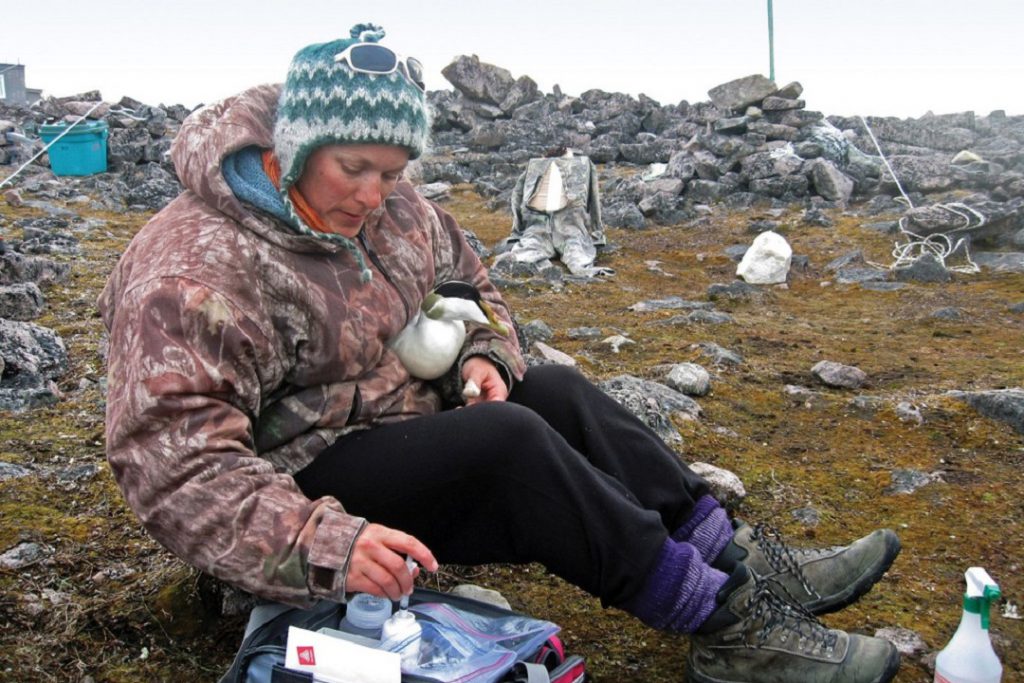Warm Warnings
Arctic waterfowl researchers explore climate change links
In summer, the seasonal wetlands along the coast of Hudson Bay in northern Manitoba are a brush-spotted maze of melt pools and soggy land. The Arctic setting is an ideal breeding ground for North America’s largest duck, the common eider.
Dotting the Bay’s western shores, at La Perouse Bay, are eider nests, each containing four or five large eggs cushioned by a soft lining of down feathers, plucked by the hen from her body.
But in late June 2013, a mother from an altogether different species occupied the eider nests. It was a hungry polar bear, and she had brought her cub along for a feast of protein-rich eggs.
A remote wildlife camera set up by graduate student David Iles captured this scene. Iles and fellow biologists like Jennifer Provencher are on the research front lines in the Canadian Arctic studying the effects of climate change on waterfowl populations. Their research is helping us better understand the actions we need to take to improve the future of waterfowl and the environment alike.
Iles and Provencher are winners of DUC’s Bonnycastle Fellowship in Wetland and Waterfowl Biology, offered through DUC’s Institute for Wetland and Waterfowl Research. Although they’ve never met, the two biologists share a passion for science that supports waterfowl conservation.
“Conservation science challenges questions and theories, but is applied in real life with species people are familiar with and depend on,” says Provencher, referring to the northern communities she partners with through her research on the common eider. Many of these communities, like the Inuit, rely on waterfowl like the common eider as a sustainable food source, as well as for the insulating value of their prized down.
Deep-diving eiders feed on marine life, providing biologists like Provencher a unique window into this otherwise inaccessible Arctic marine environment. Provencher looks at the relationships between contaminants and parasites found in the birds to understand how they influence eider reproduction rates, which has been declining in some areas. Melting sea ice and industrialization are largely human-induced contributors to the rise of contaminants like mercury in Arctic ecosystems.
While Provencher battles the elements alongside Inuit hunters on degrading ice shelves in Canada’s Far North, Iles is at a remote camp 30 kilometres outside of Churchill, Man. getting a firsthand look at how climate change is affecting waterfowl.
Iles and a group of fellow scientists spend months at a time trudging around the waterlogged summer wetlands along the Hudson Bay coast, studying life cycles of lesser snow geese and common eiders and collecting footage from more than 80 wildlife cameras pointed at their nests. Some nest sites are reached only by helicopter, while others are at times inaccessible due to carnivorous neighbours, like the polar bear mother and cubs seen snacking on eider eggs.
Iles’s cameras primarily focus on nests of lesser snow geese, a species that has overtaken the northern tundra. Habitat changes have had a huge impact on the continental snow geese population in recent decades. A greater availability of higher-yielding crops, such as rice and corn, provides snow geese with an abundant food supply that has helped their population explode from 1.5 million in the 1960s to somewhere between 6.2 and 15 million birds today – the actual number is a topic of wide debate due to estimation methods. In the tundra, grazing geese are notorious for ripping up kilometres of plants for feeding and nesting.
By examining the timing of different seasonal patterns such as migration, nesting, plant growth and predators, Iles hopes to discover the role climate change in the North plays on snow goose numbers “If any or all of these seasonal events become out of synch with one another, it could have big effects on waterfowl populations,” says Iles.
An obvious example is the earlier arrival of polar bears due to rapidly melting sea ice. The seal-deprived bears are supplementing their diet by eating geese, eggs and goslings – an interaction that wouldn’t have been as common a couple decades ago. In the past, polar bears would still be out on the sea ice while geese nested. Iles’ footage of these encounters has garnered coverage by both National Geographic and The New York Times. The latter sent a film crew to spend time capturing the scientists at work.
While hungry polar bears and contaminated eiders make arctic research seem a gloomy pursuit, Provencher and Iles remind us to not lose sight of the benefits this research provides. Findings from similar research have helped inform everything from hunting regulations to global policy, such as the Minimata Convention on Mercury – a treaty signed by more than 120 countries to control mercury pollution.
“It’s amazing to show how studying seabirds will help in the long term with international global policy,” says Provencher. “Research like this helps make the world a better place. It’s a rare opportunity.”
Scientists like Iles and Provencher are revealing how small ecosystem imbalances can have far-reaching impacts.
“I think people need to be more aware of the important linkages between different systems – that effects in one system can have important consequences in others,” advises Iles. “And that’s the type of thing we are trying to research.”
Jennifer Provencher was the recipient of the IWWR’s Bonnycastle Fellowship in Wetland and Waterfowl Biology from 2014 to 2016. David Iles was a recipient of this fellowship from 2014 to 2015.



